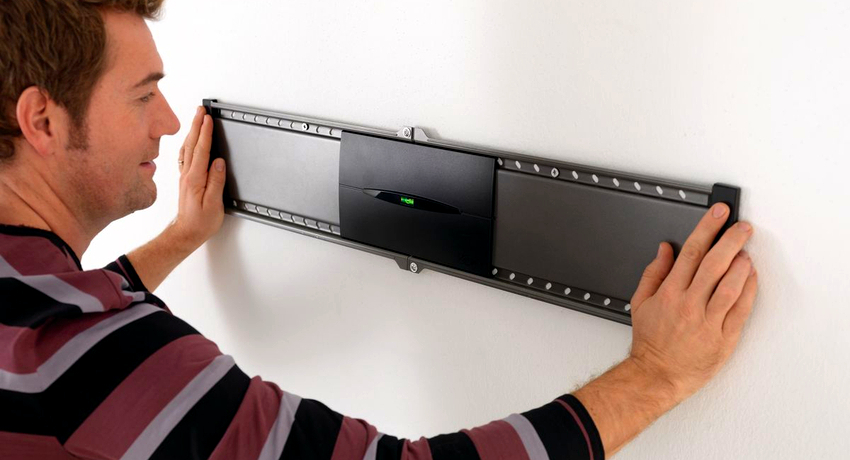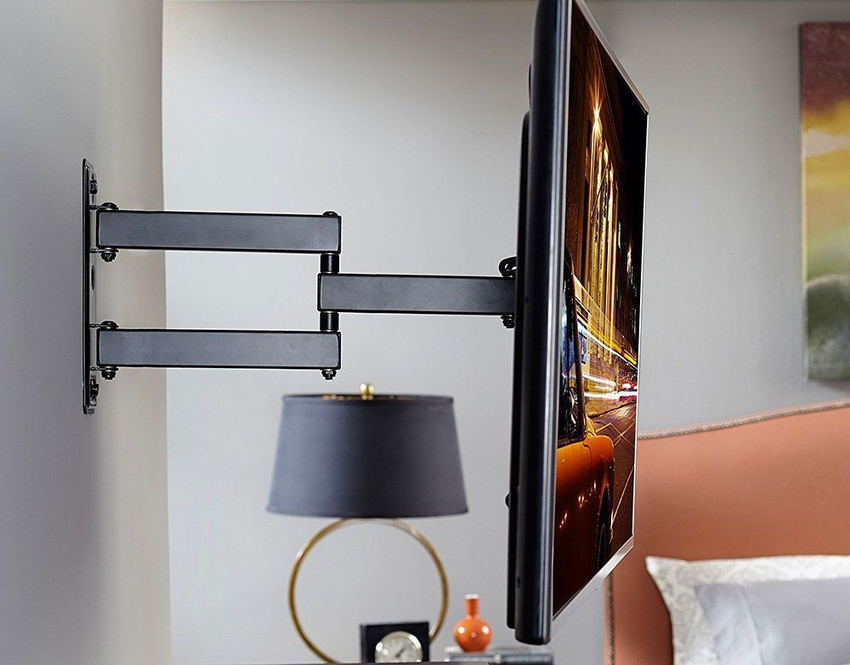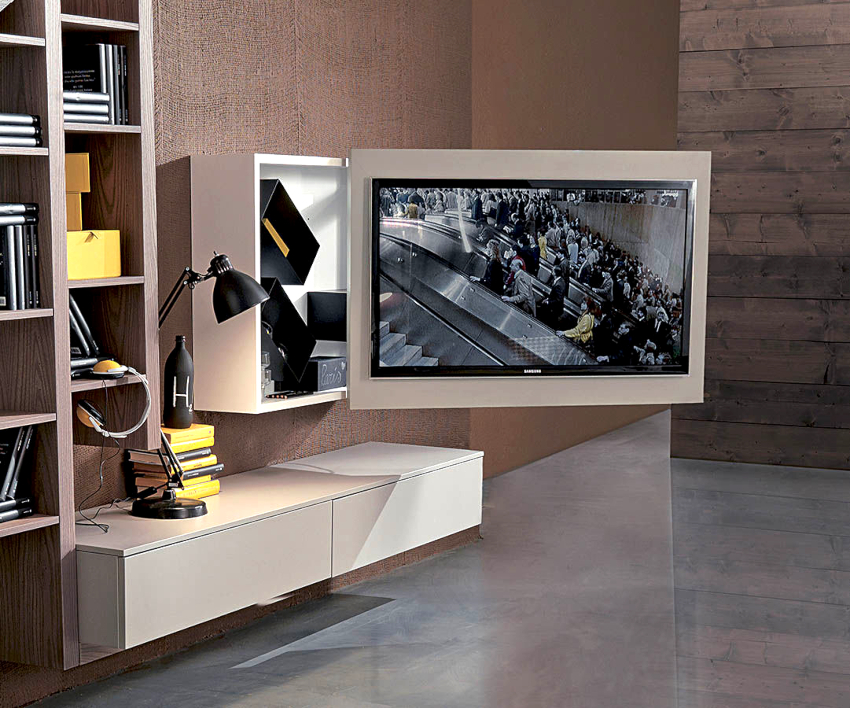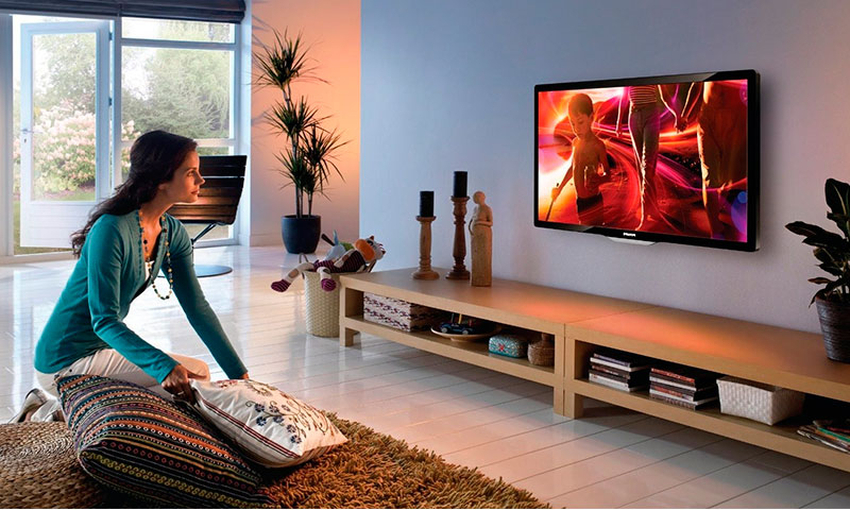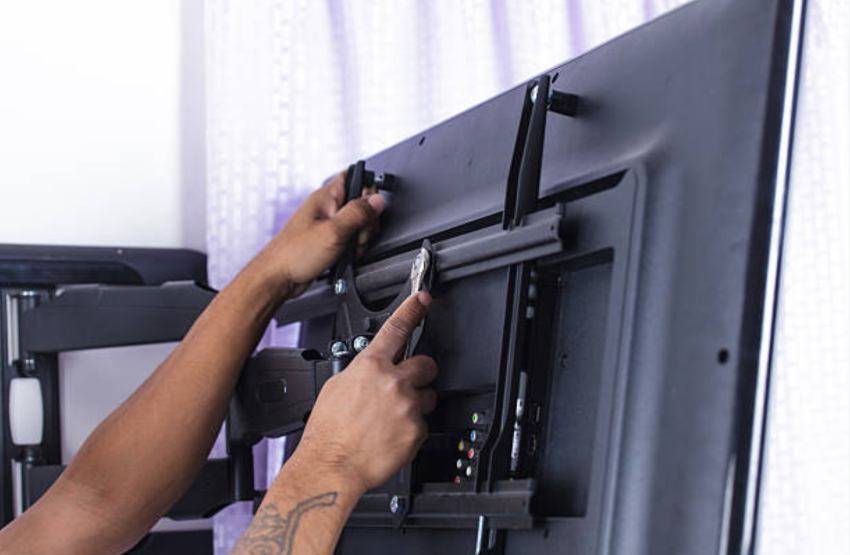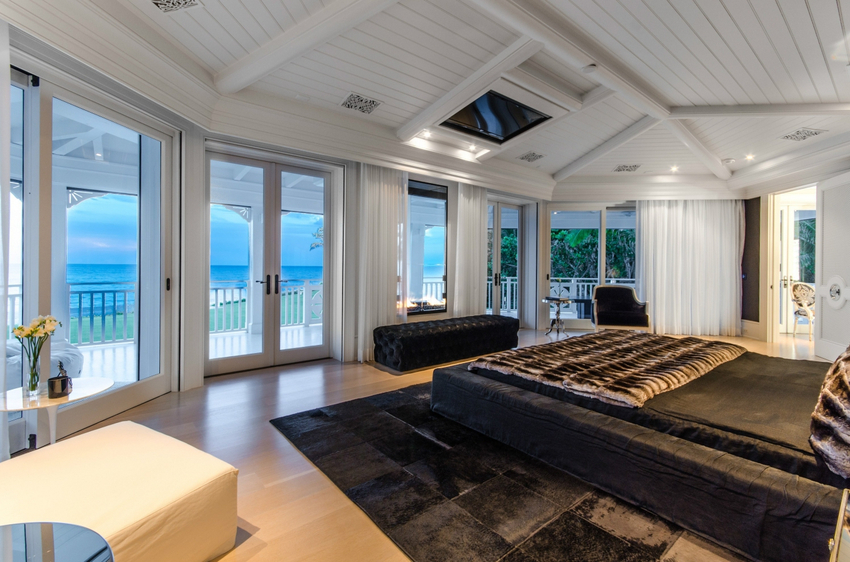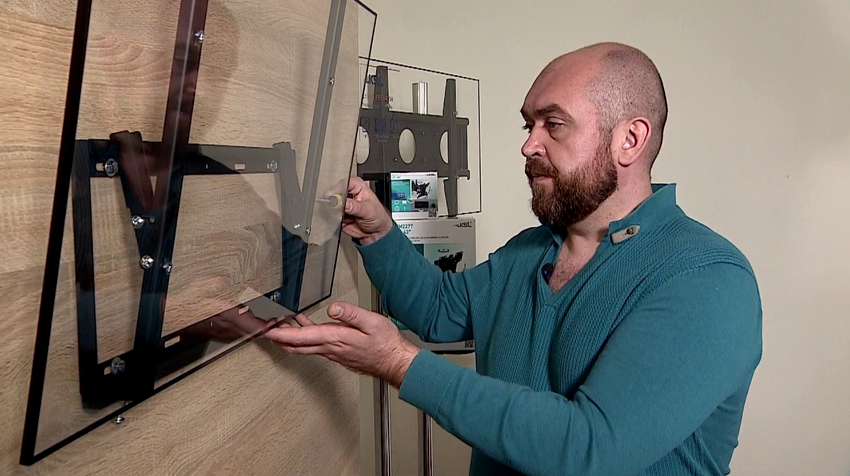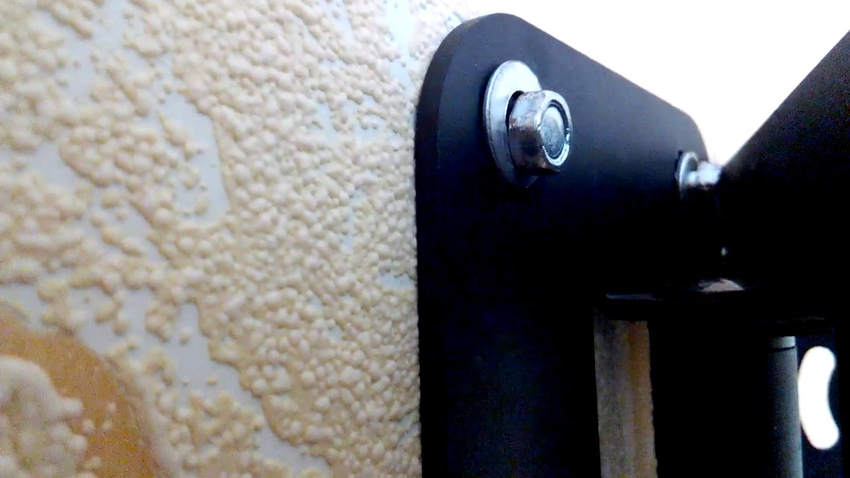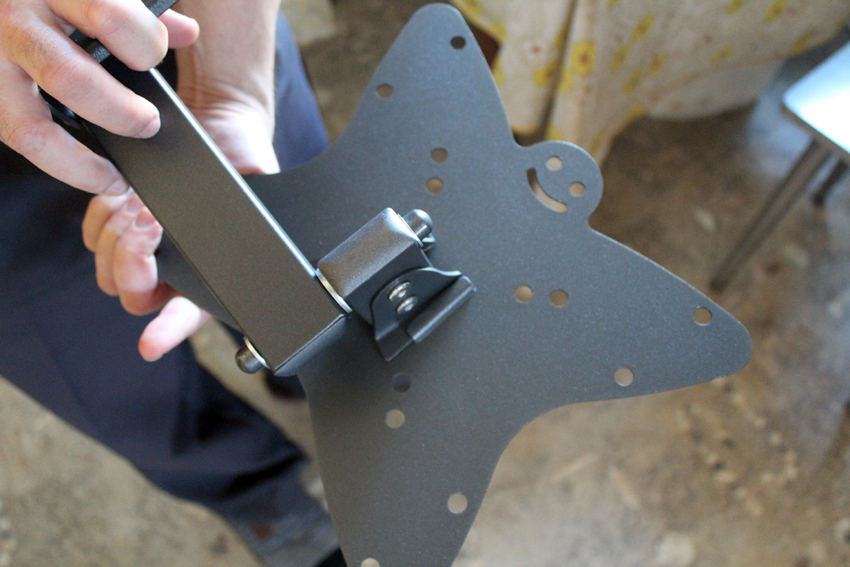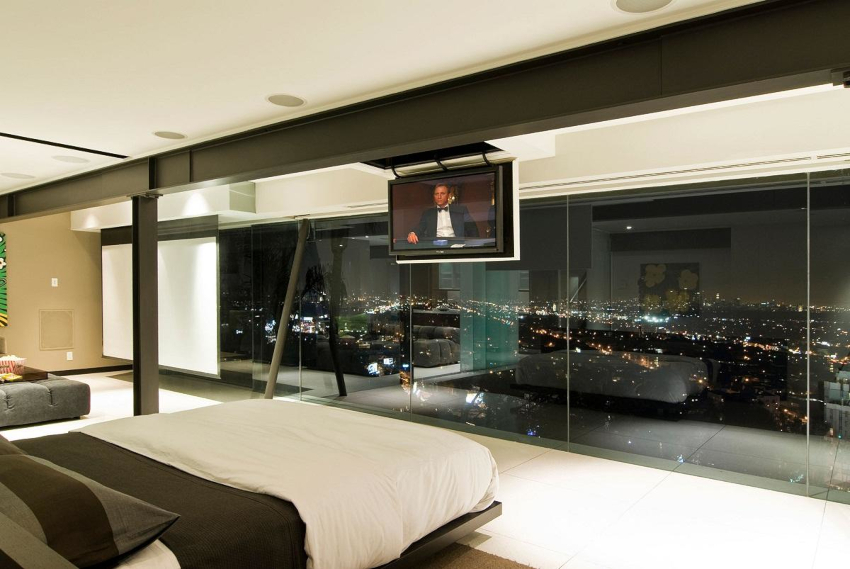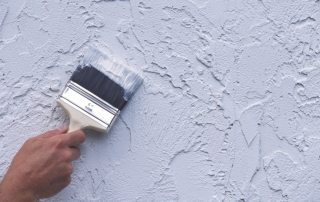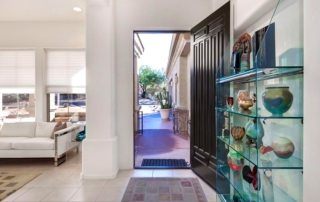Using a special mount for TVs, you can safely and reliably fix the equipment on a wall or ceiling, without fear that the panel will fall and break during operation. This article will help you understand the existing types of brackets, choose the most suitable and high-quality option, and also successfully install it indoors.
Content [Hide]
TV mount: advantages and disadvantages of using
Thanks to innovative technologies, modern TVs have become flat. In this case, the size of the diagonal of the devices can be different. On sale you can find not only standard, but also compact, even huge TVs. However, even large devices are relatively lightweight, so they can be hung with a bracket on a wall or ceiling.
Benefits of using brackets:
- Possibility to mount the TV on any vertical surface.
- The TV panel installed on a table or bedside table can be easily touched and broken. This will not happen with the bracket.
- Saving free space in the room.
- Organic placement of the TV panel in the interior of the room.
- The ability to create an ergonomic design by using TV wall mounts with a pivot that allows you to change the position of the panel depending on where the audience is.
- Affordable price.
- Compact dimensions.
A TV wall mount has many benefits. It is convenient and reliable, invisible and able to provide a comfortable environment for watching films and programs.
Useful advice! If you attach a special LED backlight, you can not only create a beautiful design, but also reduce the contrast, as well as reduce eye strain.
These products are widely used in everyday life, although they are not without drawbacks:
- Installation of mounts is possible only if there are sockets used to connect the TV. If not, installing the bracket will incur additional costs.
- The fastener is almost invisible behind the TV case, which is not the case with the wires that hang down. To disguise them, you will have to purchase a special box.
- It is imperative to organize a storage system next to the TV panel, for example, shelves where you can place additional equipment, discs with music and movies, a remote control, a game console, etc.
- Do-it-yourself installation of the holder requires certain knowledge and skills.
- If you want to move the TV to another place, you will need to perform a lot of time-consuming operations.
- After removing the panel, traces remain on the wall, so you will definitely have to change the finish.
- Over time, under the influence of weight, the mounts will bend.
- Poor installation may cause the TV to fall.
The main types of TV brackets, their features
There are several classifications according to which the TV brackets are divided into types. By the nature of the location of the base attachment site, there are:
- Wall mounted - the most common type of product.
- Ceiling - used in cases where it is necessary to install the TV in the center of the room with the ability to rotate 360 °.
- Floor Standing - These stands are used for mass events such as work meetings and presentations. For convenient transportation, such structures are provided with wheels, as well as shelves for installing additional equipment.
- Desktop - most often used when organizing a workplace with a computer monitor, although an option with a TV is also possible.
Depending on the design, the TV mounts can have different degrees of freedom. Taking this parameter into account, the following types of brackets are distinguished:
- fixed;
- tilt-swivel;
- inclined.
Important! The swivel angle shown in the product specification does not include the size of the TV. In practice, it may be less. The angle of rotation depends on the diagonal of the screen.
Retractable model of a swivel TV holder on the wall
The swing-out bracket is considered the most convenient mounting option to use. These products offer the maximum amount of degrees of freedom, allowing the wearer to adjust the position of the flat screen as they wish.
Using a swing-out TV bracket with a retractable design, you can not only fix the screen in any convenient position, but also move the device itself. The holder allows you to push the equipment close to the wall or install it perpendicular to it. In addition, it is possible to adjust and fix the screen at any angle.
It is advisable to install retractable versions of pivot mounts along the walls, which are located on the sunny side of the building. This type placing a TV will prevent glare from entering. To do this, simply turn the screen away from the window.
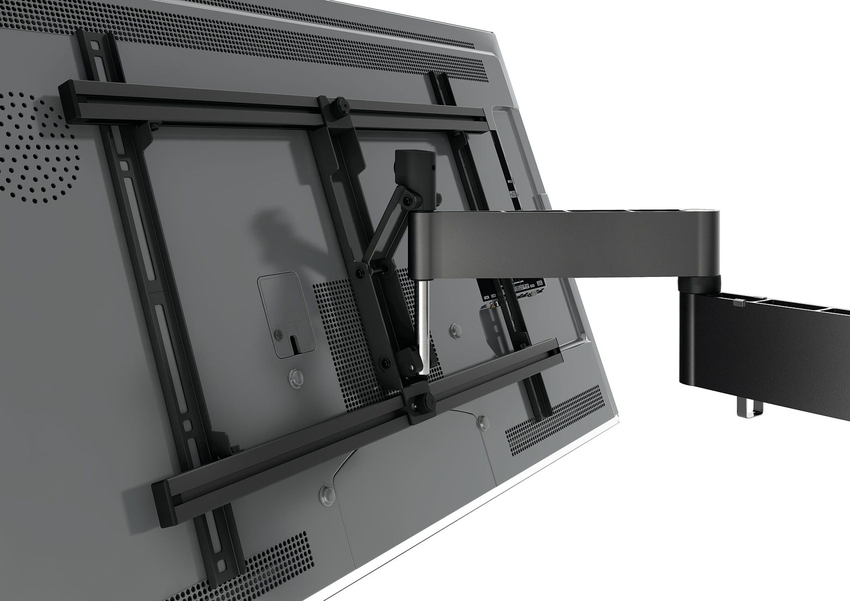
Using a retractable swivel TV bracket, you can not only fix it in a comfortable position, but also move it to the side
The bracket allows you to slide the TV forward, thereby increasing the distance to the wall. This function will come in handy if in the future it is planned to rearrange the chairs and sofa in the room. Thus, the bracket can be used to adapt the position of the wall-mounted TV to the updated environment.
Tilting model of a swivel TV mount on the wall
The tilting swivel arm allows you to change the position of the TV, as well as adjust the angle of its tilt. Regardless of where the plasma panel is installed, this type of mount allows you to adjust the plane of the screen in the horizontal or vertical direction to provide the most comfortable viewing environment.
Advantages of the Tilt-and-Swivel TV Wall Mount:
- comfortable and convenient screen position adjustment;
- the ability to quickly select and adjust the position of the screen to any viewing point in the room;
- allows you to install a TV set in a corner area, so you can successfully beat the interior of rooms with a non-standard layout.
Note! On sale you can find brackets for the TV, which can independently adjust the position of the TV panel using the remote control. Of course, the cost of such mounts is much higher than the price of conventional models.
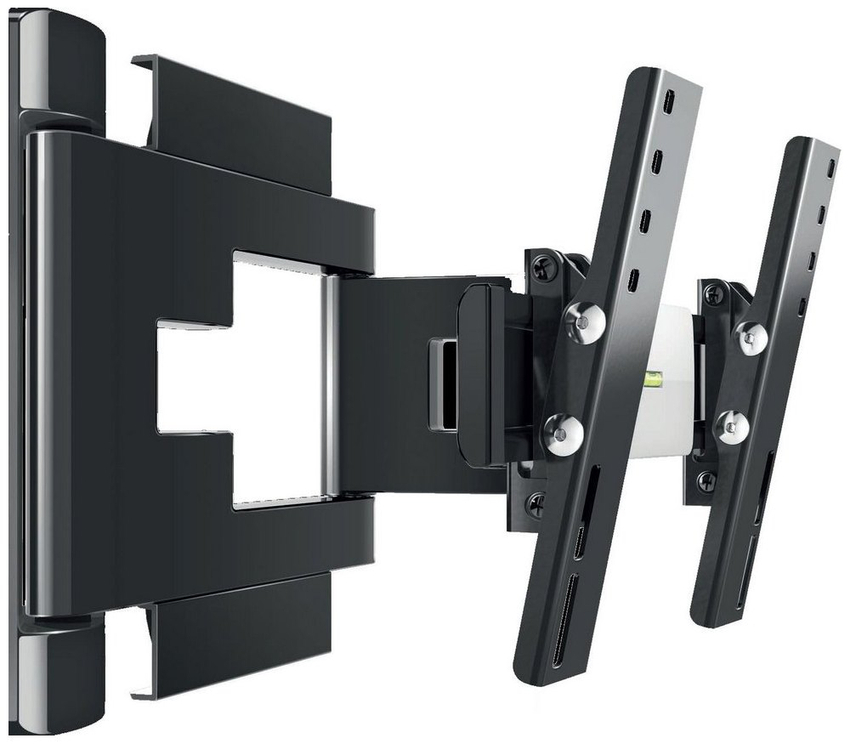
To be able not only to change the position of the TV, but also to correct its angle of inclination, you need to use a pan-tilt bracket
Disadvantages of using a tilt-and-swivel TV stand on a wall:
- only a specialist can install such a structure, since this requires special skills and knowledge;
- a large distance is formed between the TV and the wall;
- high price;
- there are weight restrictions.
Features of TV angle bracket
Corner mounts for plasma TVs allow you to install equipment in the corner of the room. This product option is very beneficial for many reasons. Firstly, the corner area is usually empty; this section of the room is very difficult to beat in the interior. Mounting the TV in this way makes it possible to rationally use this space.
Secondly, the design of corner mounts is in many ways similar to swing-out brackets, so they also successfully solve problems with the furnishings of rooms with a non-standard layout.
Thirdly, the TV is installed on one of the walls, but at the same time it is possible to view it from different points in the room. Fourthly, the panel can simply be folded when not in use, without fear of snagging during cleaning. Owners of small apartments where space is limited will be able to appreciate this advantage.
The design advantages do not end there. The corner version of the TV bracket on the wall can be called a universal mount. This type of product does not have to be used only in the corner of the room. With it, you can install the TV even in the middle of the wall.
Types of ceiling mounts for TVs
Ceiling mount views allow you to watch TV from any corner of the room with the ability to swivel and tilt the screen. Manufacturers produce fasteners even for enterprises. Such products have an increased margin of safety and moisture resistance, and they are also able to withstand high loads.
Existing types of ceiling mounts for TV:
- Inclined - designed for large-sized devices with a large weight. These mounts are highly durable.
- Swivel-tilt - used for mounting TVs, the diagonal size of which does not exceed 40 inches.
Note! A ceiling-mounted TV not only frees up space in the room, but also allows you to divide the room into zones. This mounting option is optimal if there are small children or animals in the house that can knock the panel over.
Various materials are used to make ceiling brackets. Experts advise to give preference to products made of metal, such as aluminum or steel. Structures with plastic components have a very limited lifespan and are unsafe. Remote control mounts are very common among ceiling brackets. They are the most convenient to use.
How to choose a TV bracket: standards and guidelines
Before buying mounts for a TV panel, it is necessary to determine exactly where the equipment will be installed and how much the selected area corresponds to the goals:
- protecting the TV from animals and children, as well as mechanical damage;
- saving free space in the room;
- creating a beautiful and ergonomic design.
If the TV will be mounted on the wall, choosing a bracket for its installation, you must adhere to certain rules. First of all, you need to pay attention to the strength characteristics of the bracket, and also take into account what level of loads it is designed for. This takes into account the weight of the TV panel. If the maximum mounting limit is 15 kg, then for a TV with a similar or close weight to this indicator, you should choose a more durable option.
It is advisable to buy products from trusted and reliable manufacturers who maintain the quality of products at a high level. But even in this case, it is better to play it safe and purchase a TV mount on the wall with an additional margin of safety (about 5-10 kg more).
Related article:
Bracket for TV on the wall swivel retractable: selection and installation
Bracket types and their characteristics. How to choose the right one and mount it on the wall.
The size of the TV diagonal is also of great importance. The bracket is selected taking into account this parameter. The recommended value (in centimeters or inches) is usually listed in the mounting specifications. For most buyers, adjustment is important. Since not all mounts allow you to change the position of the screen, you need to make sure this function is available. Some models of wall mount TV holders provide additional features, such as shelves where you can put speakers and a tuner, or a box for masking wires.
Useful advice! It is desirable that the TV case and bracket are in the same color. In this case, the mount will not be too conspicuous. Gray, black and white shades are considered standard, although combined options can also be found.
Vesa-labeled brackets are the most common mounting option. The products of most manufacturers have this inscription. They belong to the category of universal products manufactured in accordance with generally accepted standards.
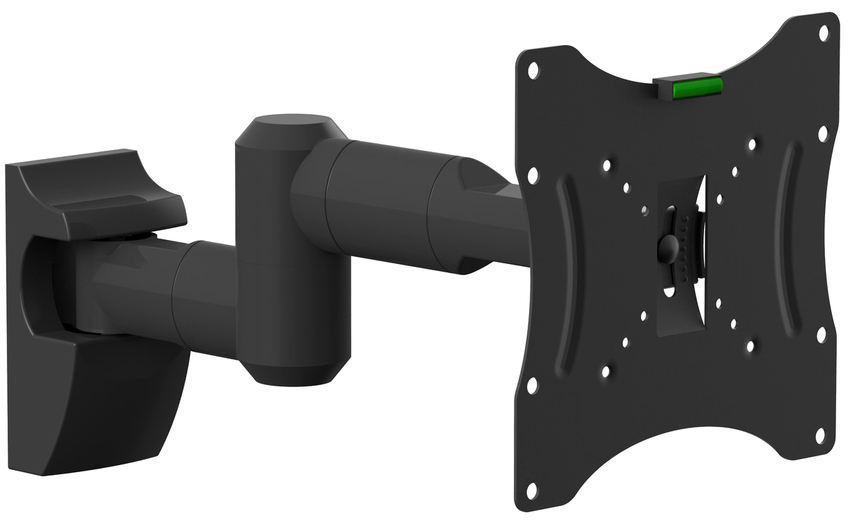
The mount is selected not only from the calculation of the loads, but also by the size of the diagonal of the TV
Vesa Common Standards System for Mounts
Vesa standards define the dimensional parameters of TV mounts. According to this system, the holes for fixing on the holders are placed at a distance of 75, 100, 200, 300 or 400 mm from each other. All home appliance manufacturers follow this standard. Therefore, brackets for TVs from Samsung, Sony, LG and other brands are selected taking into account the parameters approved by the Electronics Standardization Association. This system also determines the thread diameter of the fasteners.
The main list of rules indicated for Vesa standards:
- To ensure that any device can be mounted on a wall, 4 holes must be made on its back. They must be threaded.
- The applied threads must comply with one of the listed standards: M8, M6 or M4.
- In most cases, the holes should be symmetrical with respect to the center of the instrument. Depending on the size of the product, they form a rectangle or square.
- The distances between the holes are clearly marked.
Recommended Vesa sizes based on TV diagonal:
| TV diagonal size, inch | Recommended Vesa standard, mm |
| <22 | 75x75, 50x50, 100x100 |
| 24 |
200x100, 100x100 |
| 26 | |
| 28 | |
| 32 | |
| 37 |
200x200 |
| 39 | |
| 42 | |
| 43 | |
| 49 |
400x400 |
| 50 | |
| 55 |
The standards shown in the table apply in most cases, although there are exceptions. This is due to the technical characteristics of some TV models. Therefore, when buying mounts, it is imperative to know the exact distance between the holes on the back of the device.
Useful advice! The instructions that come with the TV usually indicate the recommended Vesa standard. However, you can get this information yourself by measuring the distance with a ruler.

When buying a bracket, you also need to know the exact distance between the holes on the back of the TV
How to choose the right TV wall mount based on the surface material
The bracket usually includes fasteners. In most cases, these are dowels. They are capable of supporting the same weight load as the bracket itself. However, the strength parameters of the fasteners in the standard configuration are determined taking into account the walls that have sufficient bearing capacity. Only concrete and brick surfaces have the required properties. In modern buildings, materials with a loose structure are often used for the manufacture of walls, in which it is impossible to securely fix the dowels. Therefore, you will have to select other retainers.
If you intend to mount the TV to a plasterboard wall, it is better to use butterfly dowels for this. These clips can be metal or plastic. Since the plasma display has an impressive weight, it is advisable to use metal fasteners.
If the base for installation is hollow or made of bulk materials, in this case it is necessary to use chemical dowels. Fasteners designed for loose surfaces and walls that crumble are in the form of an ampoule or capsule with an adhesive composition, supplemented with a pin or anchor. Clips for hollow bases, in addition to this set, also have a mesh cylinder. For thin walls, experts recommend using bolts or studs, since the screws and dowels are too long. During installation, they can come out from the other side of the wall.
How to make and install a TV wall mount
Before proceeding with the installation of the mount, it is necessary to choose the optimal place for its placement. First, the height is selected. In this case, you need to take into account the type of furniture that is in the room. It is generally accepted that the most comfortable and convenient conditions for watching TV are provided when the middle of its screen is located approximately at eye level. In the living room, people usually sit in armchairs or on a sofa. Taking this fact into account, the optimal installation height for the TV bracket is 1-1.2 m from the floor.
Similarly, the height of the TV panel mounting in the bedroom is determined. In this case, viewing is most often done while lying on the bed, so the mount will be placed lower. However, in the supine position, it is more comfortable to look not straight ahead, but slightly higher, so the optimal height for installing the bracket will be 1 m.
Important! The indicated height should be the middle of the TV screen.
Optimal viewing distance between TV and furniture:
| TV diagonal size, inch | Distance to the sofa, m |
| 26 | 1-2 |
| 30 | 1,1-2,3 |
| 34 | 1,3-2,6 |
| 42 | 1,6-3,2 |
| 47 | 1,8-3,6 |
| 50 | 1,9-3,8 |
| 55 | 2,1-3,9 |
| 60 | 2,3-4,6 |
| 65 | 2,6-4,9 |
How to make a wall mount for a TV with your own hands
The supporting structure of the TV mount on the wall with your own hands can be made from four aluminum corners. The wall thickness of these elements is 0.3 cm, and the minimum width is 2.5 cm. If you choose narrower parts, it will be inconvenient to work with them. The use of steel corners is allowed. They are much more durable, but these parts are more difficult to handle.
The corners are cut taking into account the distance between the holes for fixing on the back of the TV panel with a small margin (2 cm on each side). The main challenge is to make holes in the corners that match exactly with those on the TV. Otherwise, it will not be possible to hang the device straight.
On those corners that will be attached directly to the wall, you can make holes arbitrarily. To install a do-it-yourself TV mount on a concrete wall, you can limit yourself to just two holes. If the base is weaker, you will need to increase the number of fixation points.
When the corners on the wall are in the desired position, you need to mark the areas where the dowels will be installed. Then you need to drill holes and insert plugs. Before you hang the corners, you need to make holes for the fixing fasteners in them. To do this, the parts are folded as they will be placed on the wall. Then markings are applied to them and holes of small diameter are formed. The structure is now ready for installation.
It remains only to combine the corners so that the holes coincide, and fix the parts in this position with fasteners. For these purposes, you can use bolts, bicycle spokes, studs and other improvised means with a sufficient margin of safety.
Useful advice! To eliminate the need to carefully adjust the holes, you can use perforated metal corners. In this case, eight elements are needed. Half of the corners will be fixed to the TV, and the remaining half to the wall. In this case, it is advisable to use small-diameter bolts as retainers.
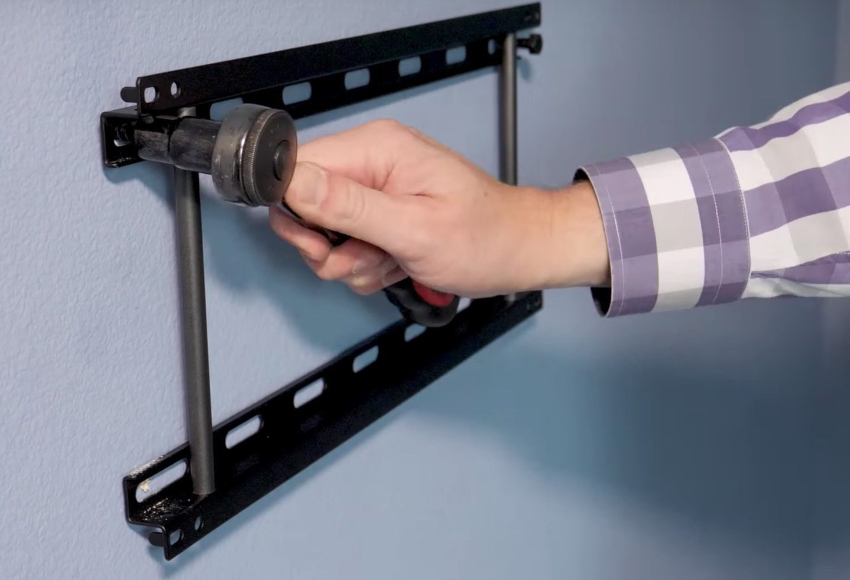
Before you hang the manufactured corners on the wall, you need to drill holes in them for fixing fasteners
How to properly mount the TV to the ceiling
The order of installation of the mount will depend on the base material. The simplest is the technology of installation on a concrete surface:
- Marking is applied to mark the points where the bracket will be fixed.
- Anchor bolts of the required length and diameter are selected.
- Drill holes of the required thickness and depth according to the size of the anchor bolts.
- The nuts are tightened, the anchor bolts are fixed in the desired positions.
- The excess thread above the nuts must be cut off.
- After that, the nuts are removed and the mount is hung.
- Wiring in progress.
- The TV is mounted, and the optimal angle of inclination is set.
If the room has suspended ceilings, the installation procedure will be as follows:
- Wiring is done in the space between the ceiling base and the suspended structure.
- In the areas where the bracket will be fixed, you need to fix the wooden blocks.
- The suspended structure is sheathed with plasterboard sheets. Previously, holes must be made in them in order to bring out the wires.
- With the help of anchor bolts, the bracket is fixed, a TV is installed on it, the required angle of inclination of the screen is set.
Wall Mount TV Bracket Technology
Installation of TV wall mounts is the same.First, a place is selected for installing the bracket, markings are applied to the wall surface with a pencil. The easiest way is to draw a line along the bottom edge of the mount. In this case, it is advisable to use the building level, so that subsequently the TV hangs exactly. Use a pencil to mark the points where the holes will be drilled.
For these purposes, you can use a drill or hammer drill. This process only takes a few minutes. When drilling holes in the wall, be sure to take into account the length and diameter of the fasteners. Be careful when doing this, as there may be hidden wiring in the wall. It is advisable to have a communication scheme with you in order to navigate in the process of work.
Then, using a hammer, you need to hammer anchors or dowels into the holes. The plate and bracket for fixing the TV to the wall are rigidly fixed with bolts. After that, you can install the equipment itself. It is advisable to do this together. The TV can be connected only after it is carefully and securely fixed, otherwise the operation of the equipment will not be safe.
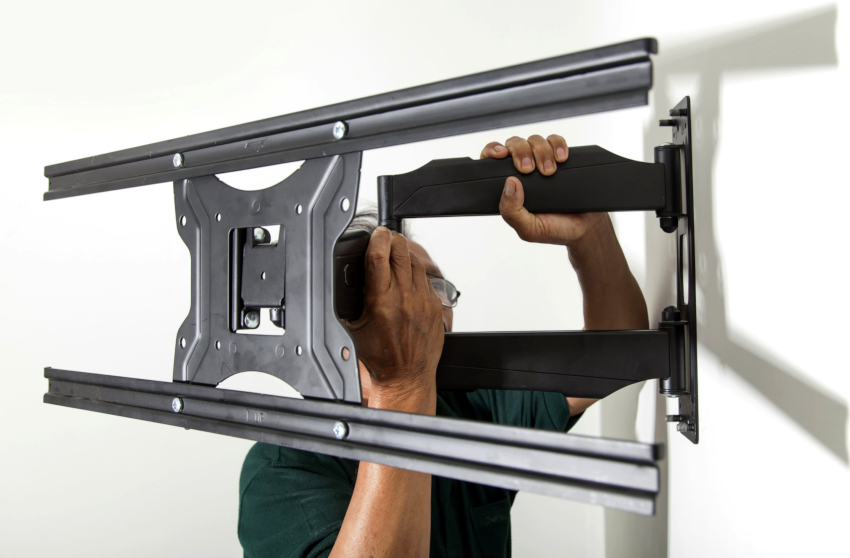
Before you start drilling holes for the dowels, you need to apply a markup that will indicate the points where the bracket will be fixed
If the TV panel will be hung on a plasterboard wall, you need to use a bracket that is fixed not at four, but at six points. To do this, you can take special butterfly dowels. It is advisable to install the mount itself on a metal profile hidden under drywall. This will increase the strength of the attachment, and also eliminate the likelihood of an accidental fall of equipment.
The process of attaching the TV to the wall is quite simple. Anyone who has basic skills in handling a perforator and a hammer is capable of mastering the installation technology. Sometimes the bracket manufacturers include a template for marking the wall with the mechanism. This insert greatly facilitates and simplifies the work.
